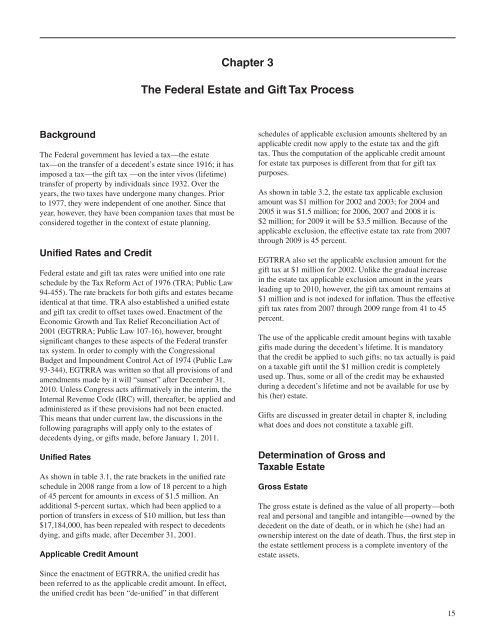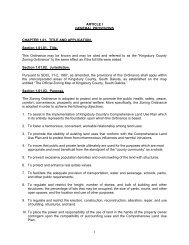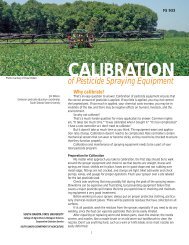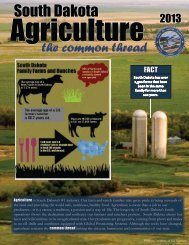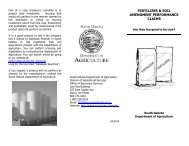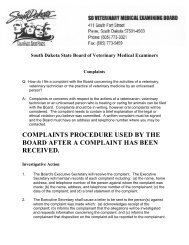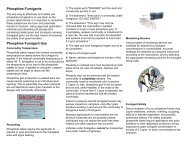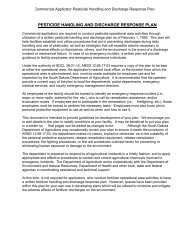Estate Planning for Forest Landowners - South Dakota Department ...
Estate Planning for Forest Landowners - South Dakota Department ...
Estate Planning for Forest Landowners - South Dakota Department ...
You also want an ePaper? Increase the reach of your titles
YUMPU automatically turns print PDFs into web optimized ePapers that Google loves.
Chapter 3<br />
The Federal <strong>Estate</strong> and Gift Tax Process<br />
Background<br />
The Federal government has levied a tax—the estate<br />
tax—on the transfer of a decedent’s estate since 1916; it has<br />
imposed a tax—the gift tax —on the inter vivos (lifetime)<br />
transfer of property by individuals since 1932. Over the<br />
years, the two taxes have undergone many changes. Prior<br />
to 1977, they were independent of one another. Since that<br />
year, however, they have been companion taxes that must be<br />
considered together in the context of estate planning.<br />
Unified Rates and Credit<br />
Federal estate and gift tax rates were unified into one rate<br />
schedule by the Tax Re<strong>for</strong>m Act of 1976 (TRA; Public Law<br />
94-455). The rate brackets <strong>for</strong> both gifts and estates became<br />
identical at that time. TRA also established a unified estate<br />
and gift tax credit to offset taxes owed. Enactment of the<br />
Economic Growth and Tax Relief Reconciliation Act of<br />
2001 (EGTRRA; Public Law 107-16), however, brought<br />
significant changes to these aspects of the Federal transfer<br />
tax system. In order to comply with the Congressional<br />
Budget and Impoundment Control Act of 1974 (Public Law<br />
93-344), EGTRRA was written so that all provisions of and<br />
amendments made by it will “sunset” after December 31,<br />
2010. Unless Congress acts affirmatively in the interim, the<br />
Internal Revenue Code (IRC) will, thereafter, be applied and<br />
administered as if these provisions had not been enacted.<br />
This means that under current law, the discussions in the<br />
following paragraphs will apply only to the estates of<br />
decedents dying, or gifts made, be<strong>for</strong>e January 1, 2011.<br />
Unified Rates<br />
As shown in table 3.1, the rate brackets in the unified rate<br />
schedule in 2008 range from a low of 18 percent to a high<br />
of 45 percent <strong>for</strong> amounts in excess of $1.5 million. An<br />
additional 5-percent surtax, which had been applied to a<br />
portion of transfers in excess of $10 million, but less than<br />
$17,184,000, has been repealed with respect to decedents<br />
dying, and gifts made, after December 31, 2001.<br />
Applicable Credit Amount<br />
schedules of applicable exclusion amounts sheltered by an<br />
applicable credit now apply to the estate tax and the gift<br />
tax. Thus the computation of the applicable credit amount<br />
<strong>for</strong> estate tax purposes is different from that <strong>for</strong> gift tax<br />
purposes.<br />
As shown in table 3.2, the estate tax applicable exclusion<br />
amount was $1 million <strong>for</strong> 2002 and 2003; <strong>for</strong> 2004 and<br />
2005 it was $1.5 million; <strong>for</strong> 2006, 2007 and 2008 it is<br />
$2 million; <strong>for</strong> 2009 it will be $3.5 million. Because of the<br />
applicable exclusion, the effective estate tax rate from 2007<br />
through 2009 is 45 percent.<br />
EGTRRA also set the applicable exclusion amount <strong>for</strong> the<br />
gift tax at $1 million <strong>for</strong> 2002. Unlike the gradual increase<br />
in the estate tax applicable exclusion amount in the years<br />
leading up to 2010, however, the gift tax amount remains at<br />
$1 million and is not indexed <strong>for</strong> inflation. Thus the effective<br />
gift tax rates from 2007 through 2009 range from 41 to 45<br />
percent.<br />
The use of the applicable credit amount begins with taxable<br />
gifts made during the decedent’s lifetime. It is mandatory<br />
that the credit be applied to such gifts; no tax actually is paid<br />
on a taxable gift until the $1 million credit is completely<br />
used up. Thus, some or all of the credit may be exhausted<br />
during a decedent’s lifetime and not be available <strong>for</strong> use by<br />
his (her) estate.<br />
Gifts are discussed in greater detail in chapter 8, including<br />
what does and does not constitute a taxable gift.<br />
Determination of Gross and<br />
Taxable <strong>Estate</strong><br />
Gross <strong>Estate</strong><br />
The gross estate is defined as the value of all property—both<br />
real and personal and tangible and intangible—owned by the<br />
decedent on the date of death, or in which he (she) had an<br />
ownership interest on the date of death. Thus, the first step in<br />
the estate settlement process is a complete inventory of the<br />
estate assets.<br />
Since the enactment of EGTRRA, the unified credit has<br />
been referred to as the applicable credit amount. In effect,<br />
the unified credit has been “de-unified” in that different<br />
15


